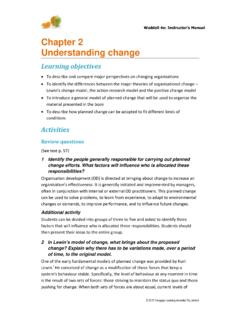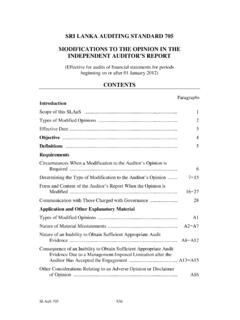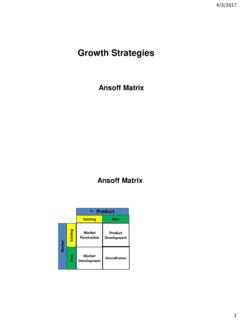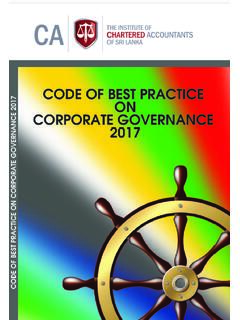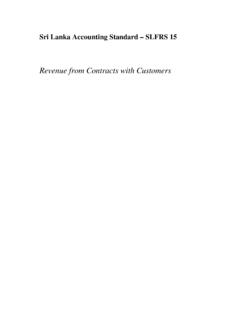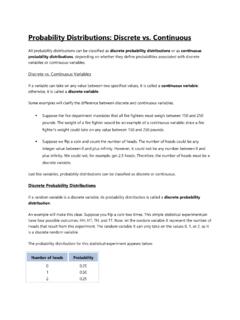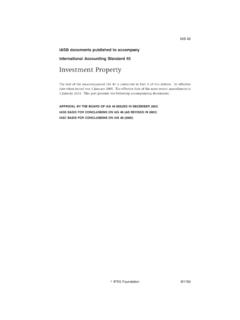Transcription of International Accounting Standard 40 - CA Sri Lanka
1 International Accounting Standard 40 investment PropertyIAS 40 BC Basis for Conclusions onIAS 40 investment PropertyThis Basis for Conclusions accompanies, but is not part of, IAS Basis for Conclusions summarises the International Accounting StandardsBoard s considerations in reaching its conclusions on revising ias 40 InvestmentProperty in 2003. Individual Board members gave greater weight to some factorsthan to July 2001 the Board announced that, as part of its initial agenda of technicalprojects, it would undertake a project to improve a number of standards ,including ias 40 . The project was undertaken in the light of queries andcriticisms raised in relation to the standards by securities regulators, professionalaccountants and other interested parties. The objectives of the Improvementsproject were to reduce or eliminate alternatives, redundancies and conflictswithin standards , to deal with some convergence issues and to make otherimprovements.
2 In May 2002 the Board published its proposals in an ExposureDraft of Improvements to International Accounting standards , with a comment deadlineof 16 September 2002. The Board received over 160 comment letters on theExposure Draft. BC3 Because the Board s intention was not to reconsider the fundamental approach tothe Accounting for investment property established by ias 40 , this Basis forConclusions does not discuss requirements in ias 40 that the Board has notreconsidered. The IASC Basis for Conclusions on ias 40 (2000) follows this interests held under an operating leaseBC4 Paragraph 14 of IAS 17 Leases requires a lease of land with an indefinite economiclife to be classified as an operating lease, unless title is expected to pass to thelessee by the end of the lease term. Without the provisions of ias 40 as amended,this operating lease classification would prevent a lessee from classifying itsinterest in the leased asset as an investment property in accordance with IAS a result, the lessee could not remeasure its interest in the leased asset to fairvalue and recognise any change in fair value in profit or loss.
3 However, in somecountries, interests in property (including land) are commonly or exclusively held under long-term operating leases. The effect of some of these leases differslittle from buying a property outright. As a result, some contended that suchleases should be accounted for as finance leases or investment property , or Board discussed possible solutions to this issue. In particular, it considereddeleting paragraph 14 of IAS 17, so that a long-term lease of land would beclassified as a finance lease (and hence could qualify as an investment property )when the conditions for finance lease classification in paragraphs 4 13 ofIAS 40 BCIAS17 are met. However, the Board noted that this would not resolve all casesencountered in practice. Some leasehold interests held for investment wouldremain classified as operating leases (eg leases with significant contingent rents),and hence could not be investment property in accordance with IAS the light of this, the Board decided to state separately in paragraph 6 (ratherthan amend ias 40 s definition of investment property ) that a lessee s interest inproperty that arises under an operating lease could qualify as investmentproperty.
4 The Board decided to limit this amendment to entities that use the fairvalue model in ias 40 , because the objective of the amendment is to permit useof the fair value model for similar property interests held under finance andoperating leases. Put another way, a lessee that uses the cost model for a propertywould not be permitted to recognise operating leases as assets. The Board alsodecided to make the change optional, ie a lessee that has an interest in propertyunder an operating lease is allowed, but not required, to classify that propertyinterest as investment property (provided the rest of the definition of investmentproperty is met). The Board confirmed that this classification alternative isavailable on a property -by- property basis. BC7 When a lessee s interest in property held under an operating lease is accountedfor as an investment property , the Board decided that the initial carryingamounts of that interest and the related liability are to be accounted for as if thelease were a finance lease.
5 This decision places such leases in the same positionas investment properties held under finance leases in accordance with theprevious version of IAS doing so, the Board acknowledged that this results in different measurementbases for the lease asset and the lease liability. This is also true for ownedinvestment properties and debt that finances them. However, in accordance withIAS 39 Financial Instruments: Recognition and Measurement,* as revised in 2003, anentity can elect to measure such debt at fair value, but lease liabilities cannot beremeasured in accordance with IAS 17. BC9 The Board considered changing the scope of IAS 39, but concluded that this wouldlead to a fundamental review of lease Accounting , especially in relation tocontingent rentals. The Board decided that this was beyond the limited revisionsto ias 40 to facilitate application of the fair value model to some operating leasesclassified as investment properties.
6 The Board did, however, indicate that itwished to revisit this issue in a later project on lease Accounting . The Board alsonoted that this was the view of the Board of the former IASC as expressed in itsBasis for Conclusions, in paragraphs B25 and B26. BC10 Finally, the Board noted that the methodology described in paragraphs 40 and50(d) of ias 40 , whereby a fair valuation of the property that takes all leaseobligations into account is adjusted by adding back any liability that is recognised*In November 2009 and October 2010 the Board amended some of the requirements of IAS 39 andrelocated them to IFRS 9 Financial Instruments. IFRS 9 applies to all items within the scope of IAS BC8 refers to matters relevant when ias 40 was issued. These paragraphs in the IASC Basis are no longer relevant and have been 40 BC for these obligations, would, in practice, enable entities to ensure that net assetsin respect of the leased interest are not affected by the use of differentmeasurement bases.
7 *The choice between the cost model and the fair value modelBC11 The Board also discussed whether to remove the choice in ias 40 of Accounting forinvestment property using a fair value model or a cost Board noted that IASC had included a choice for two main reasons. The firstwas to give preparers and users time to gain experience with using a fair valuemodel. The second was to allow time for countries with less-developed propertymarkets and valuation professions to mature. The Board decided that more timeis needed for these events to take place ( ias 40 became mandatory only for periodsbeginning on or after 1 January 2001). The Board also noted that requiring the fairvalue model would not converge with the treatment required by most of itsliaison Standard -setters. For these reasons, the Board decided not to eliminate thechoice as part of the Improvements project, but rather to keep the matter underreview with a view to reconsidering the option to use the cost model at a Board did not reconsider ias 40 in relation to the Accounting by of investment property requires that such a property is held bytheowner or a lessee under a finance lease.
8 As indicated above, the Board agreedto allow a lessee under an operating lease, in specified circumstances, also to be a holder . However, a lessor that has provided a property to a lessee under a financelease cannot be a holder . Such a lessor has a lease receivable, not an Board did not change the requirements for a lessor that leases property underan operating lease that is classified and accounted for by the lessee as investmentproperty. The Board acknowledged that this would mean that two parties couldboth account as if they hold interests in the property . This could occur at variouslevels of lessees who become lessors in a manner consistent with the definition ofan investment property and the election provided for operating leases. Lesseeswho use the property in the production or supply of goods or services or foradministrative purposes would not be able to classify that property as aninvestment property under constructionBC15In response to requests for guidance, the Board revisited the exclusion ofinvestment property under construction from the scope of ias 40 .
9 The Boardnoted that investment property being redeveloped remained in the scope of the*Subsequently, the Board concluded that the drafting of paragraph 50(d) was misleading because itimplied that the fair value of an investment property asset held under a lease was equal to the netfair value plus the carrying amount of any recognised lease liability. Therefore, in Improvements toIFRSs issued in May 2008 the Board amended paragraph 50(d) to clarify the intended 40 BCStandard and that the exclusion of investment property under construction gaverise to a perceived inconsistency. In addition, the Board concluded that withincreasing experience with the use of fair value measures since the Standard wasissued, entities were more able to measure reliably the fair value of investmentproperty under construction. Therefore, in the exposure draft of proposedImprovements to International Financial Reporting standards published in 2007 theBoard proposed amending the scope of the Standard to include investmentproperty under respondents supported the Board s proposal.
10 However, many expressedconcern that including in ias 40 investment property under construction mightresult in fewer entities measuring investment property at fair value. This wasbecause the fair value model in the Standard requires an entity to establishwhether fair value can be determined reliably when a property first becomes aninvestment property . If not, the property is accounted for using the cost modeluntil it is disposed of. In some situations, the fair value of investment propertyunder construction cannot be measured reliably but the fair value of thecompleted investment property can. In these cases, including in the Standardinvestment property under construction would have required the properties to beaccounted for using the cost model even after construction had been , the Board concluded that, in addition to including investmentproperty under construction within the scope of the Standard , it would alsoamend the Standard to allow investment property under construction to bemeasured at cost if fair value cannot be measured reliably until such time as thefair value becomes reliably measurable or construction is completed (whichevercomes earlier).

